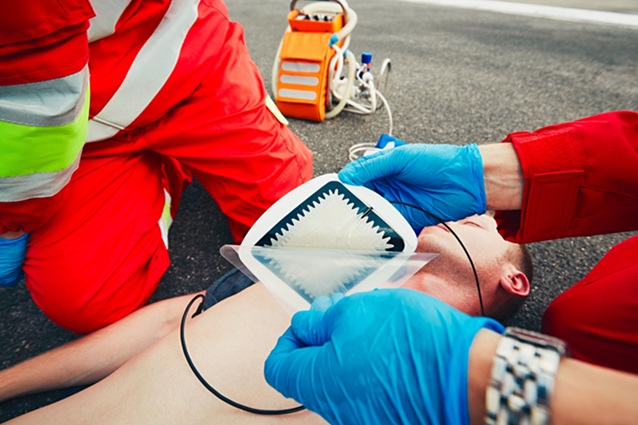New Defibrillation Approach Improves Cardiac Arrest Outcomes
|
By HospiMedica International staff writers Posted on 23 Sep 2024 |

Out-of-hospital cardiac arrest (OHCA) remains a major cause of death worldwide. Ventricular fibrillation (VF) and pulseless ventricular tachycardia (pVT) are the most treatable causes of OHCA, and rapid defibrillation using pads placed in either the anterior-posterior (AP) or anterior-lateral (AL) position increases the chances of survival with good neurological outcomes. However, many patients with shockable rhythms like VF or pVT do not respond to the initial defibrillation attempts. While extensive research has been conducted on the optimal pad placement for cardioversion in atrial fibrillation, no prospective studies have been done to determine the ideal initial pad positioning for OHCA due to VF or pVT. A new study now suggests that the initial positioning of defibrillator pads may significantly impact the likelihood of restoring spontaneous circulation after defibrillation in individuals experiencing out-of-hospital cardiac arrest.
In the observational study published in the journal JAMA Network Open, researchers at the Oregon Health & Science University (Portland, OR, USA) analyzed data from the Portland Cardiac Arrest Epidemiologic Registry, which tracked defibrillation pad placement from July 1, 2019, through June 30, 2023. Researchers reviewed 255 cases treated by Tualatin Valley Fire & Rescue, focusing on whether the defibrillator pads were placed in the front and side (AL) or front and back (AP). The findings revealed that placing the pads in the front and back increased the odds of returning spontaneous circulation by 2.64 times compared to the front-and-side placement.
Current practice among healthcare professionals suggests that both pad positions—front and side, or front and back—are equally effective during cardiac arrest. However, the study's results indicate a potential advantage in placing the pads on the front and back, possibly because this configuration more effectively "sandwiches" the heart, allowing the electrical current to reach the organ more comprehensively. The researchers stressed that this study is observational and not a definitive clinical trial, but the findings suggest that front-and-back pad placement may improve outcomes in cardiac arrest cases. However, practical limitations exist, such as when patients are overweight or in positions that make front-and-back placement difficult. Ultimately, pad positioning is just one of several factors that contribute to the successful treatment of cardiac arrest.
“The key is, you want energy that goes from one pad to the other through the heart,” said senior author Mohamud Daya, M.D., professor of emergency medicine in the OHSU School of Medicine.
Latest Critical Care News
- Mass Manufactured Nanoparticles to Deliver Cancer Drugs Directly to Tumors
- World’s Smallest Pacemaker Fits Inside Syringe Tip

- AI-Powered, Internet-Connected Medical Devices to Revolutionize Healthcare, Finds Study
- Starfish-Inspired Wearable Tech Enables Smarter Heart Monitoring
- AI Eye Scans Could Help Identify Heart Disease and Stroke Risk
- Digital Heart Twin Improves Diagnosis and Treatment of Cardiac Arrhythmias
- First-Of-Its-Kind AI-Powered Probability Scoring System Assesses Heart Failure with Preserved Ejection Fraction
- AI-Assisted Colonoscopy Detects More Polyps but Has Modest Effect on Cancer Risk
- Wearables Could Reduce Need for Continuous Blood Thinners in Patients with Atrial Fibrillation
- AI Model Provides Real-Time Sepsis Risk Alerts for Improving ICU Patient Survival
- AI Algorithm Improves Intravenous Nutrition for Premature Babies
- Smart Mirror Generates AI-Powered Health Insights by Analyzing Facial Blood Flow
- Painless Diabetes Patch to Replace Needle Pricks

- Sensory T-Shirt Monitors Patient’s Vitals After Urological Surgery for Cancer
- Super-Sensitive Radar Technology Warns of Serious Heart Issues
- Thermal Imaging Could Accurately Track Vital Signs for Early Disease Detection
Channels
Surgical Techniques
view channel
New Transcatheter Valve Found Safe and Effective for Treating Aortic Regurgitation
Aortic regurgitation is a condition in which the aortic valve does not close properly, allowing blood to flow backward into the left ventricle. This results in decreased blood flow from the heart to the... Read more
Minimally Invasive Valve Repair Reduces Hospitalizations in Severe Tricuspid Regurgitation Patients
The tricuspid valve is one of the four heart valves, responsible for regulating blood flow from the right atrium (the heart's upper-right chamber) to the right ventricle (the lower-right chamber).... Read morePatient Care
view channel
Portable Biosensor Platform to Reduce Hospital-Acquired Infections
Approximately 4 million patients in the European Union acquire healthcare-associated infections (HAIs) or nosocomial infections each year, with around 37,000 deaths directly resulting from these infections,... Read moreFirst-Of-Its-Kind Portable Germicidal Light Technology Disinfects High-Touch Clinical Surfaces in Seconds
Reducing healthcare-acquired infections (HAIs) remains a pressing issue within global healthcare systems. In the United States alone, 1.7 million patients contract HAIs annually, leading to approximately... Read more
Surgical Capacity Optimization Solution Helps Hospitals Boost OR Utilization
An innovative solution has the capability to transform surgical capacity utilization by targeting the root cause of surgical block time inefficiencies. Fujitsu Limited’s (Tokyo, Japan) Surgical Capacity... Read more
Game-Changing Innovation in Surgical Instrument Sterilization Significantly Improves OR Throughput
A groundbreaking innovation enables hospitals to significantly improve instrument processing time and throughput in operating rooms (ORs) and sterile processing departments. Turbett Surgical, Inc.... Read moreHealth IT
view channel
Printable Molecule-Selective Nanoparticles Enable Mass Production of Wearable Biosensors
The future of medicine is likely to focus on the personalization of healthcare—understanding exactly what an individual requires and delivering the appropriate combination of nutrients, metabolites, and... Read more
Smartwatches Could Detect Congestive Heart Failure
Diagnosing congestive heart failure (CHF) typically requires expensive and time-consuming imaging techniques like echocardiography, also known as cardiac ultrasound. Previously, detecting CHF by analyzing... Read morePoint of Care
view channel
Handheld, Sound-Based Diagnostic System Delivers Bedside Blood Test Results in An Hour
Patients who go to a doctor for a blood test often have to contend with a needle and syringe, followed by a long wait—sometimes hours or even days—for lab results. Scientists have been working hard to... Read moreBusiness
view channel
Expanded Collaboration to Transform OR Technology Through AI and Automation
The expansion of an existing collaboration between three leading companies aims to develop artificial intelligence (AI)-driven solutions for smart operating rooms with sophisticated monitoring and automation.... Read more


















